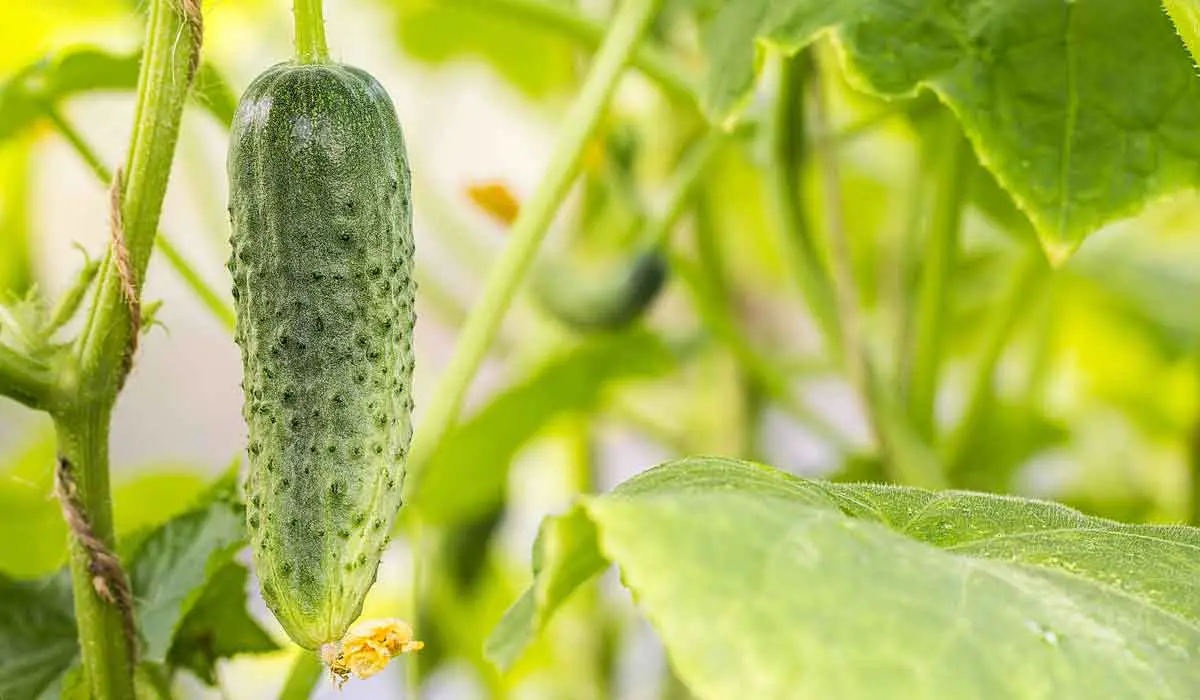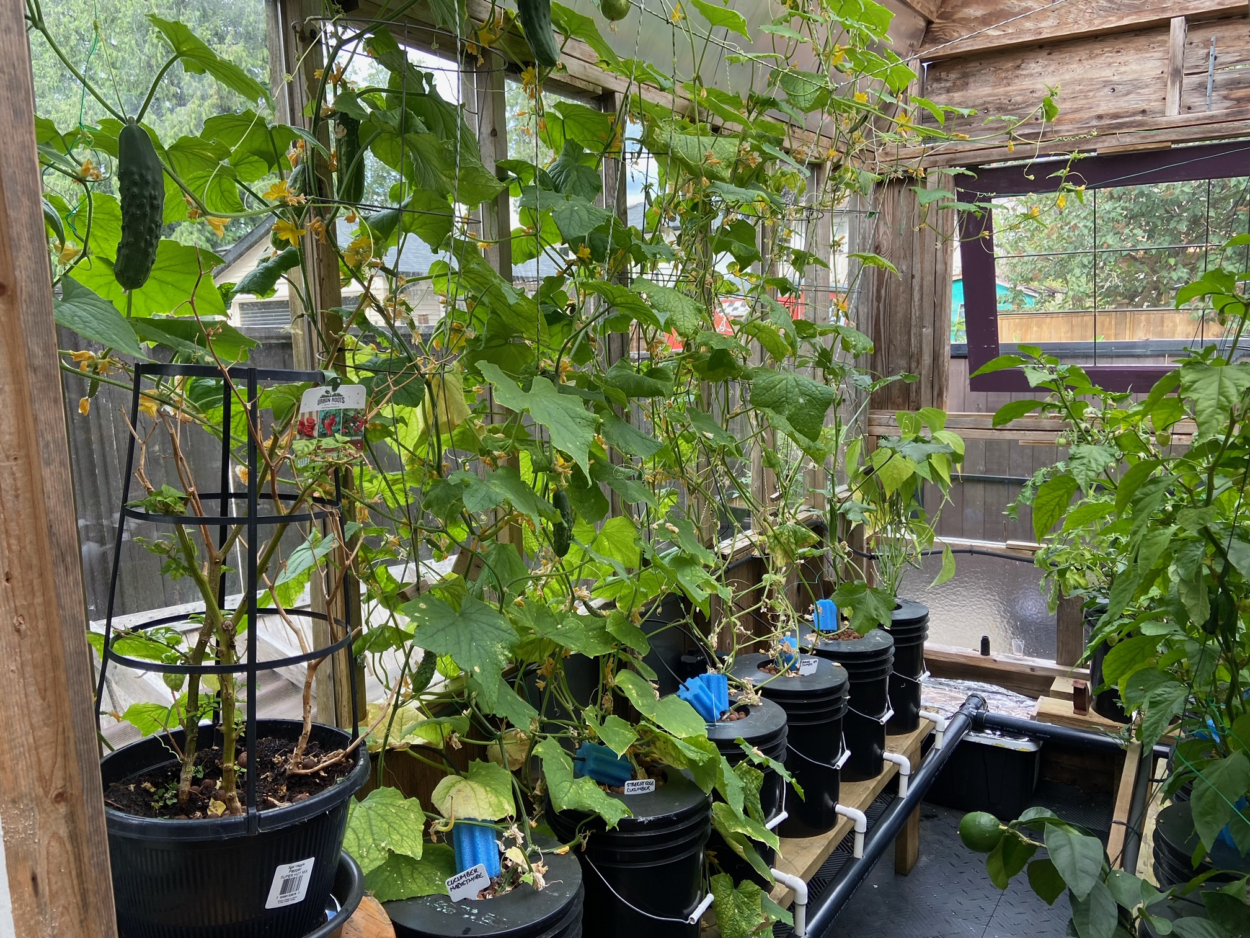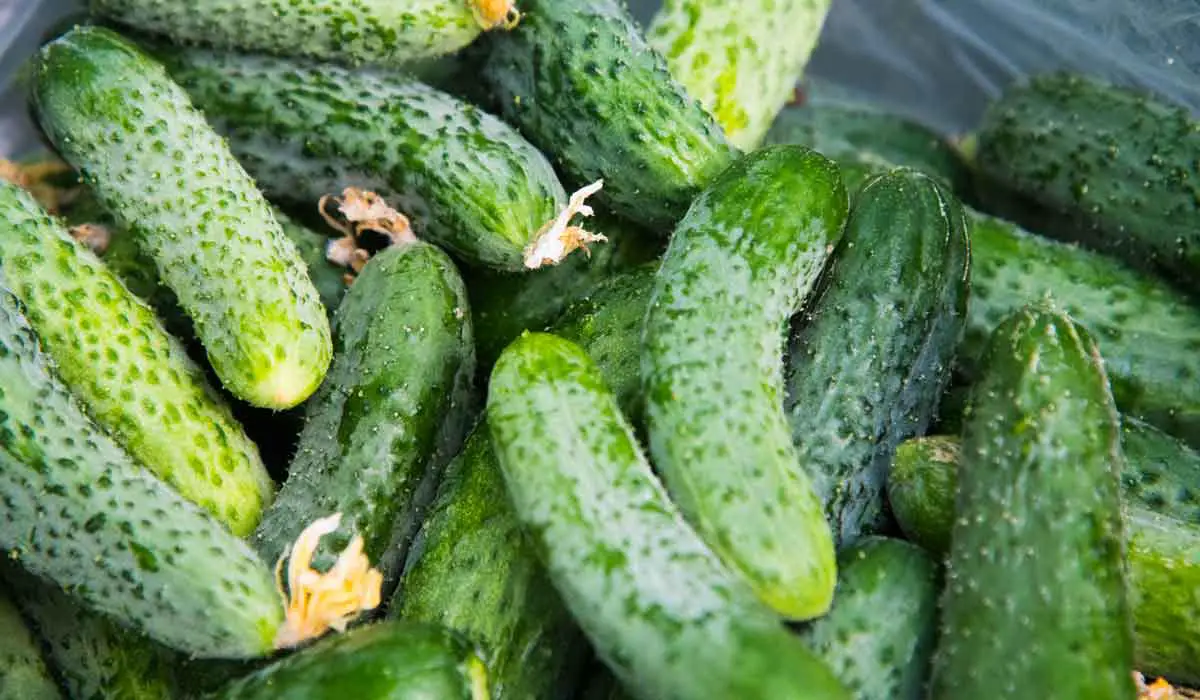The Secret to Growing Hydroponic Cucumbers: The Ultimate Guide to Indoors Cucumber Production

This post follows our research editorial guidelines.

Cucumbers are one of the true superstars of hydroponic cultivation. They’ll thrive in just about any type of hydroponic system with a bit of work and the right attitude. If you’ve got the space to set aside be prepared to learn just how easy and versatile a crop the humble cucumber truly is. Here’s what you need to know about hydroponic cucumbers and how to get your own harvest in no time flat.

Table of Contents
Can You Grow Cucumbers Hydroponically?
It’s very easy to grow hydroponic cucumbers indoors. They thrive in many hydroponic systems and are a common greenhouse crop. Many cucumber varieties flourish in protected cultivation and grow well in many hydroponics systems, including Dutch Bucket and passive Deep Water rigs.
| Hydroponic Setup Requirements For Cucumbers | |
| Light | 16 hours of bright, broad spectrum light a day |
| Water | pH 5.0-6.0 |
| Growing Medium | Any |
| Nutrients | EC 1.7 – 2.0 |
| Pruning | Not recommended |
| Spacing | 1 per five square feet; consider training to utilize vertical area |
| Temperature | Cool, between |
| Pests | Squash bugs, spider mites, aphids, thrips, scale. |
| Disease | Mildew and other leaf diseases |
The Secret to Healthy Hydroponic Cucumber Plants
The secret to healthy cucumber plants in your home hydro system is space. They don’t really want much from their nutrient solution, and depending on the variety of cucumber you opt for you won’t need to pollinate either. But what hydroponic cucumbers need is space. If you don’t plan for that before you start growing it won’t take long before they’re overtaking your entire growing area.
Cucumber vines love to spread. When growing your own cucumbers in a grow room you’ll need to have a plan to deal with an exuberant sprawling mass of vines and huge, dinner-plate sized leaves.
The good news is they take readily to trellises and can be grown in vertical gardens so the cucumbers will hang downwards in rather fetching green cascades. They’re surprisingly tough too so cucumbers can be grown outside on a well-lit deck or porch in much of the country.
In fact, my friend David has quite the setup in his outdoor greenhouse. He grows plenty of vining cucumbers next to beans and hot peppers and herbs.

Starting Cucumber Seeds Hydroponically
To start cucumber seeds hydroponically, you will need:
- cucumber seeds
- soil-free seed raising medium – coco peat is ideal
- propagation tray or clear plastic container with lid
- clean water
Step One: Select Your Seeds
Start by selecting your seeds. Self-pollinating varieties like the European are a good choice. Smaller varieties can be eaten as a salad cucumber or pickles too! Ensure you avoid seeds for field cucumbers – they aren’t the best for hydroponic production.
You’ll also need to choose a seed-raising medium best for your rig. Coco peat is good for bedded systems, and starter plugs work well for Deep Water or Nutrient Film rigs.
Step Two: Prepare your Growing Medium
Prepare your medium. Place half an inch of growing medium in your propagation tray and water until it’s moist without being sodden. Starter plugs will need to be soaked overnight and then placed in the tray with a shallow film of water at the bottom to maintain hydration.
At this point only use pure water. Seeds are self-contained and don’t need hydroponic fertilizer to germinate.
Step Three: Plant Your Seeds
Plant your seeds one per plug or a quarter of an inch deep into the seed-raising mix. Only plant a few. Cucumbers germinate readily and it’s likely all will produce strong seedlings. Close the lid to maintain good humidity, and pop the lot in a well lit, cool area.
Step Four: Keep Seeds Warm Until True Leaves Appear
Keep your seedlings in the tray for around 5 to 6 weeks. Once their first set of true leaves are fully developed feed with a half-strength nutrient solution, typically between three to five days after sprouting. Young cucumber plants grow at a surprising rate and need that extra nutrition.
Once the seedlings are 6 weeks old transplant them to the rig. Plugs are easiest and can simply be picked up and planted in one piece. For seedlings in the loose growing medium, gently free the roots and plant in baskets as normal.

Can cucumbers be grown hydroponically from cuttings?
Cucumbers grown from seeds are best for hydroponic cultivation. They do not grow readily from cuttings at all.
How to Grow Hydroponic Cucumbers
Light
Cucumber plants grow very rapidly and consequently need a lot of light. Aim for 16 hours of bright broad-spectrum light a day.
You’ll have to watch out for overlapping leaves. If you cramp their style too much the cucumber plant may well shade itself and restrict its growth as a result.
Water
Cucumbers require an acidic nutrient solution in order to keep their roots healthy and well-nourished. A pH of between 5 to 6 is good, though it’s best to aim for lower. They are particularly vulnerable to iron deficiency and other nutritional issues if the pH creeps up.
Growing medium
You name it, and cucumbers will grow in it. They aren’t fussy about their growing medium at all. Most commercial hydroponic growers opt for Dutch buckets with blends of perlite, sawdust, sand or vermiculite. Vertical systems tend to prefer airy media with extensively exposed roots.
Nutrients
Despite what their vigorous growth would suggest cucumbers are not heavy feeders. Aim for a hydroponic nutrient solution with an EC between 1.7 and 2.0.
That said, poorly nourished vines will sometimes develop small, stunted fruit with weird proportions. They bend and have a strange warty texture, so when it comes to cucumbers it pays to watch out for poor nutrient solution supply.
Don’t rely on the leaves to indicate a problem. Cucumber plants will produce leaves like mad even when the EC drops below 1.6, so it’s easy to fall into a false sense of security.
Pruning

Put down the pruning shears and let your cucumbers spread out. Each leaf is critical when it comes to growing its crisp sweet fruit. Too few leaves and you can kiss your crop goodbye.
If they really are taking over consider training upwards. They trellis readily and so long as you keep the light coming cucumbers will grow in any orientation. Commercial hydroponic crops are almost always grown high above ground on trellises, and many varieties quite enjoy danging downwards. If you’re in the right area growing cucumbers outside will allow them to really spread out.
Spacing
In perfect conditions, cucumbers require five square feet per plant. They need that much space to accommodate the sprawl of leaves. If they’re trained to grow upwards or allowed to hang from a vertical garden you can allow five square feet of vertical space. European cucumbers are best suited to grow along overhead trellises with the fruit itself dangling below for easy harvest, and smaller pickling varieties will quite happily trail downwards.
Temperature
Cucumbers prefer daytime temperatures of between 75 – 80° F. They’ll tolerate down to around 55° F overnight, but much lower than that will have a damaging impact on your crops. Let the temperature creep up and your cucumbers may just not bother setting fruit at all. It pays to keep things cool as a…well, you get the picture!
Pollinating Cucumbers Grown Indoors
Many traditional cucumber cultivars like the Lebanese cucumber must be pollinated by hand. Hydroponic culture indoors tends to eliminate pollinating insects altogether I like to use a small soft paintbrush to move pollen from the smaller, plainer male flowers and apply it to the females. Female flowers have a prickly ovary that resembles as small cucumber at the base that makes them easy to spot. These varieties of cucumber will sometimes develop small and misshapen fruit if they don’t receive good pollination so take your time and be thorough.
I prefer to avoid the fuss choose seeds from varieties that don’t require pollination. They’re known as parthenocarpic cucumbers. They swell with fruit no matter how little attention their flowers receive. As a bonus they tend to be seedless cucumbers with thinner, more delicious skins.
“Cucumber plants, like squash, melons, and many other plants have separate male and female flowers on the same plant. You can recognize the male flowers because they do not have a small fruit behind them. They produce the pollen needed to form the fruit, but they do not produce the fruit. The female flower on the other hand has a small fruit behind the flower even before it opens.”
Marisa Y. Thompson, Extension Horticulture Specialist, New Mexico State University

Pests
Cucumbers attract all manner of garden nasties but thankfully for us growing inside defeats even the worst of them. If you do want to grow outdoors, watch out for the array of squash bugs known to plague cucurbits. Hose the plant off regularly to remove them or consider releasing beneficial insects.
Cucumbers cultivated hydroponically indoors do still have a few pests to content with. Watch for the usual suspects of spider mites, aphids, thrips, mealy bugs and scale. They can be hand picked if you catch them early enough. Given how large cucumbers can get it’s often more practical to apply a commercial insecticide instead.
Diseases
Since cucumbers are cucurbits you’ll need to watch out for mildew. This appears as a silvery blush to form on the surface of the leaves. They soon brown from the edges in and drop off entirely. Stressed cucumbers will produce little to no fruit at all so it’s important to keep the well ventilated to prevent mildew getting a foothold in your rig.
Home growers can treat stricken leaves with 10% dilution of full fat milk in water, sprayed over the leaves twice a week. When exposed to ultraviolet light the milk releases free radicals that destroys the mildew. It can take a few applications but I’ve found it one of the best natural treatments for the disease.
Cucumbers are also vulnerable to hard-to-treat fungal leaf diseases, including Botrytis and Anthracnose. Avoid them by maintaining low humidity and good ventilation.
Frequently Asked Questions
Are Hydroponic Cucumbers Healthy?
All cucumbers are equally as healthy. A hydroponic cucumber nutrient profile is no different to one grown in conventional systems, provided its needs are met.
It’s not the technique itself that makes or breaks a food like cucumbers. It’s all about how well they’re grown in the first place. Cucumbers grown in the best hydroponic system in ideal conditions will be far more nutritious than those grown in poor soils with inadequate amounts of light. Conversely if you pay poor attention to your solution even a low feeder like cucumbers will only produce bland, misshapen fruit with poor vitamin content.
How long do cucumbers take to grow hydroponically?
Cucumber Plants Are Fast Growers. They Will Take As Little As Five Weeks For Greenhouse Cucumbers To Produce Their First Fruit. Most Hydroponic Cucumbers Need A Little Longer And Will Take Two To Three Months From Seed To Harvest.
Get your cucumbers in good strong light, with good ventilation and the right nutrition and many hydroponic cucumber varieties will start producing fruit in as little as five weeks. It’s more typical to wait two months between cucumber seed sowing and your first harvest, so don’t despair if it takes a little longer for your first batch of fruit to come in.
Can you Grow cucumbers in AeroGarden?
Cucumbers grow well in larger Aerogarden systems like the Aerogarden Farm. Be sure to allow adequate space for the plant to spread, and do not overcrowd the system.
While it’s tempting to fill in the space around your cucumbers by starting new plants beneath the trailing vines, I don’t recommend it. Cucumbers really do need all that space, with the ventilation and access to all the light it entails.
Cucumbers also need more acidic solution that most. If you skip that in favor of co-planting other crops it causes cucumbers to develop a bend in the fruit or to come in stunted. If the solution is out they can’t access their nutrients properly and consequently produce some weird fruit.
Final Thoughts
I love having different foods growing at different times all through my various rigs and systems. When you know how to grow hydroponic cucumbers in addition to tomatoes and lettuce it’s a snap to have fresh salads all year round. All the work suddenly seems worth it the moment you get the first cucumber ready to serve.

Before you go!
9 Cheapest Alternatives to Hydroponic Rockwool
Which AeroGarden is best? My review of each model in comparison to buy
The Secret To Growing Hydroponic Beans: A Complete Guide To Growing the Best Beans Indoors
The 10 Best Plants to Grow in Hydroponic Gardens (And 3 to Skip)